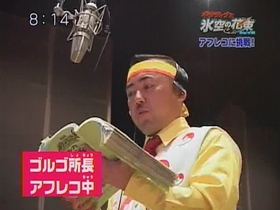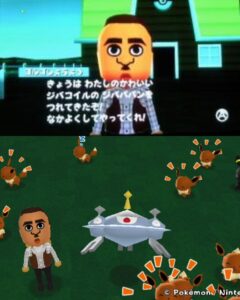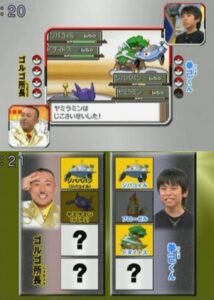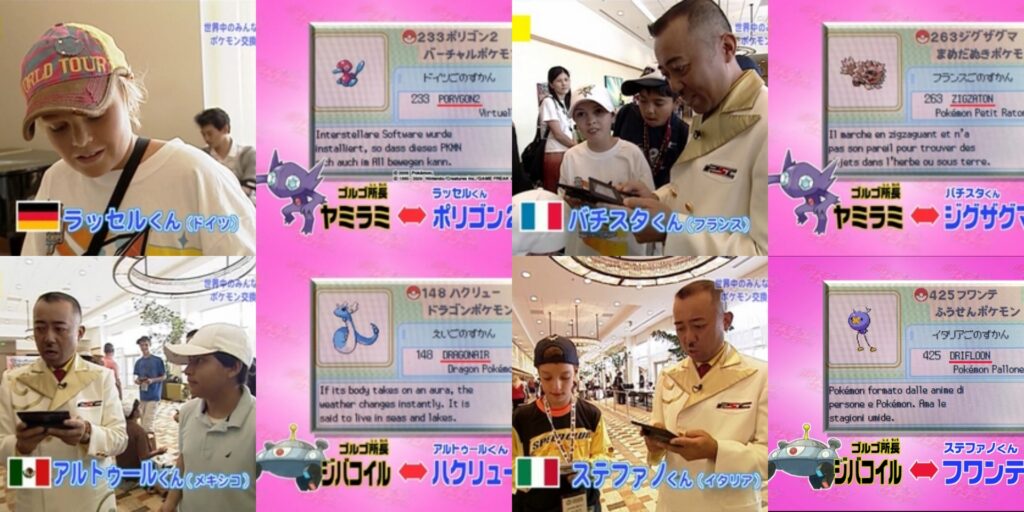“Hot battles were held everywhere! But the actual temperature was … chill[y] because of air conditioners! Freezing!”
Temperatures were sweltering in San Diego, the scorching mid-August sun baking the Hilton Bayfront hotel where the 2009 Pokémon World Championships were held. Pokémon Sunday‘s dynamic duo of Professor Red and Chief Golgo seemed comfortable enough inside its air-conditioned hallways, their minds focussed on the task at hand: to communicate the who’s who and what’s what of “Worlds” to Japan’s television audience.
Later that month, the fruits of their labour aired on Pokémon Sunday (#254). A mini-feature showed Golgo & Red going about the special reporter fact-finding mission on which the show had sent them, touching base with the attendant Japanese delegation, commentating on the ins-and-outs of the TCG and VGC tournaments, and – somewhat surprisingly – interacting with international participants. Not only that: a televised string of Pokémon Platinum-based exchanges saw Chief Golgo give out several of his signature creatures to a lucky few youthful contestants from all over the world. This is the story of these quasi-event Pokémon commonly known as “Goruchans”, and the remarkable yet obscure Pokémon Sunday shenanigans that inspired them.
Hapless Jibacoil(s): Chief Golgo & Magnezone
Giratina and the Sky’s Bouquet is among the most enduringly popular of the 2000s Pokéfilms, and for good reason. Movie 11 is notable for fleshing out the backstories to Shaymin, a class of telepathic cuddly-looking hedgehogs, and Giratina, a fierce and monstrous-looking multipedal whose intimidating appearance belies a gentle demeanor and unwavering devotion to the greater good. On the plot side, this middle instalment in a Diamond & Pearl trilogy stars a fallen genius (Zero) not content to peacefully co-inhabit a world filled with intellectually inferior mortals. Quite naturally, he therefore seeks domination of the “Reverse World” presided over by Giratina. While flying mostly solo in this pursuit, the larger-than-life antihero does enjoy the company of a levitating steely sidekick: Zero’s Magnezone.
In commanding and corralling a battalion of Magnemites, Zero’s Magnezone – or “Jibacoil”, in Japanese – is regularly sent on missions to harass and intimidate those those who would foil Zero’s plans. As you might expect from a viewer-friendly Pokéfilm, however, Magnezone’s petite hitsquad poses little practical danger to the likes of Shaymin, Giratina, and the battle-hardened Pokémon of Ash, Dawn and Brock. Though Magnezone can be seen frenetically firing off moves such as Discharge and Mirror Shot in various scenes, the closest it comes to inflicting actual harm is when it unexpectedly bursts through the window of a moving train car in an attempt to kidnap an unimpressed Shaymin from under Ash and Pikachu’s noses… Only to take a retaliatory angry Thunderbolt to the face, comically tumble from the train and get plastered against a conveniently positioned rock face. Yeah. Not quite fit for the job, Zero’s Magnezone is altogether most competent in the capacity of on-demand private elevator to help his master get in and out of towering apocalyptic machinery. Levitation sure is handy!
Giratina and the Sky’s Bouquet premiered in Japan on July 19, 2008. The Pokémon Sunday episode that aired a day later (#196) devoted ample time to celebrating the newly released feature film. In this context, a good chunk of airtime was taken up by Sunday’s very own Bouquet of the Sky movie quiz where a silver-suited Yamamoto, Baba and Akiyama were enlisted as panellists to be tested on their knowledge of the film’s events and, in particular, the various parts filled by its voice actors.1As you may know, voice acting is a high-profile career in Japan – much more so than in the Anglosphere – and its biggest stars are held in equal esteem with old-fashioned silver screen moviestars.
Now, a sneak preview in Sunday #193 had teased footage of Matsumoto at work in a Tokyo recording studio, sporting his usual outlandish white-and-gold Pokeball suit, and with a colourful PC Tokyo “Focus Band” tied around his head for either style or good luck.2 The very episode in which Golgo famously failed to win back his beloved Octillery in an ultimate final showdown. As such, it was public knowledge by this point that Chief Golgo had been asked to perform voice-acting for Movie 11. (Note that it was not Masahiko Matsumoto – the real-life comedian behind Golgo – who took on the job as some extramural VA side-gig; rather, it was very expressly his Pokémon Sunday that was commissioned the part.) However, the exact nature of Chief Golgo’s contribution had been kept from both the television audience and Sunday’s cast… Until now.
With the NDA’s ripped up, quizmaster Shokotan posed “Robert” the question: which one of these Pokémon that appear in the film did the Chief voice – Shieldon, Altaria, Magnezone, or Wingull? The trio mulled over the possibilities, and all jotted down different answers: Baba thought it must have been Altaria, Akiyama went with Shieldon,3 I think… Each held up a sign with their answer; the text is hard to make out on the grainy images available to me. while Yamamoto bet on Magnezone. As cameras panned to Chief Golgo, he struggled to keep a straight face… Then after a dramatic pause finally dropped the big reveal: he had voiced Zero’s Magnezone!
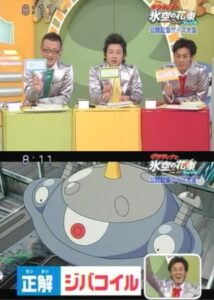
Three different panelists, three different answers (top); Yamamoto guesses correctly (bottom). Stills from: Pokémon Sunday #196, via pocketmonsters.net
Baba, Akiyama, and Yamamoto were momentarily surprised – and then they were not. Chief Golgo as Zero’s Magnezone was a casting choice that made oodles of intuitive sense. If you’re stretched for the parallels: Golgo and his animated alter-ego were both characters far less intimidating, and far more farcical, than their job descriptions suggested they might be. While Golgo was canonically supposed to be the solemn authority figure that runs Sunday – the Chief, after all – in practice he possessed perhaps the biggest boke giggle factor of all the cast. And the existential dissonance was even stronger for Magnezone, who as Zero’s right-hand Poké-man is by occupation a threatening and aggressive presence that, instead of harming anybody at all, wholly unwittingly turns into be the film’s primary source of comedic relief. This resonance between Golgo and Magnezone makes for the most intuitive of intuitive fits – so much so that I can practically feel Junichi Masuda’s guiding hand in allocating Magnezone’s part to the Golgo persona.
Sunday proceeded to show a reel of footage shot at Golgo’s dubbing session, where the Chief evinced an… Unusual technique to produce raw Magnezone audio. By rapidly rubbing his left index finger across his lower lip while reading out Magnezone’s “lines” to the studio mike, Golgo produced a bizarre vibrato effect that, after the application of some artistic audio distortion, evidently came out suitably electromagnetic. The end result as audible in the film variously reminds me of the saliva-spraying flubbing noise made by Gungan Boss Nass when he learned Jar Jar owed a life debt to a human and Big Bang Theory’s Simon Helberg doing his best robotic Hawking impression. Quite understandably, these scenes of a crazed-looking Golgo maniacally bouncing his index finger off pouted lips had Sunday’s cast in stitches.
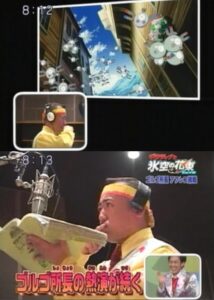
Golgo’s unusual technique is caught on camera, inviting laughter from Sunday’s cast. Stills from: Pokémon Sunday #196, via pocketmonsters.net
Two things are important here. First, by accident or by design, these remarkable scenes had birthed a canonical special relationship between the Chief and Zero’s Magnezone. And second, this relationship clearly harboured tremendous comedic potential for Sunday to exploit. Which, spearheaded by Chief Golgo himself, the show very much did, even if it took some months for the wheels to be set in motion.
You see, in the Summer of 2008, the age of Pokémon Diamond & Pearl (D&P) was rapidly drawing to a close. The release of Pokémon Platinum, that perfected “third version” of the Sinnoh adventure, was scheduled for September of that year, and Sunday dedicated much studio time to coverage of the gameplay improvements it promised. Platinum’s imminent arrival also inspired revision of the ruleset of Sunday’s “Battle Corner” (discussed at length here). Where the show had mainly featured 3v3 singles brawling since the inception of D&P-based, televised staff-on-staff and staff-on-challenger Poké-battles in late 2006, with the arrival of Platinum, matchups were to assume the standard VGC doubles format commonly used in official competitions.4 Which is to say, a 4v4 with two Pokémon on the field adjacently at any given time. Moreover, an origin game of Platinum was mandated for all Pokémon to be fielded under the new rules. In practical terms, this meant that old favourites like Golgo Octillery and Yamamoto Whiscash were barred from participation. As such, all of Sunday’s cast had to raise and prepare new Pokémon for battle!
You can see where this is going, right? Now, from the instant that news broke of Chief Golgo’s Bouquet of the Sky voice-acting gig, fans speculated that he might raise a self-referential Magnezone for use in battle. A netapoke thread spanning dozens of posts made throughout July-August 2008 debated matters such as how a hypothetical Magnezone would complement Golgo’s Octillery and Sableye, what its inevitable nickname might be, and whether the Chief might think to employ a Trick Room strategy and bestow his sluggish favourites a speed advantage. This latter point invited particular back-and-forth, with arguments hinging on whether Golgo was considered to have sufficient game knowledge to use Trick Room effectively. The discussion was ultimately put to bed by one poster’s observation that since Golgo is a unique personality, he might just do anything5 In the original Japanese: “まず、ゴルゴは個性派だから普通にジバコイル使おうと思ってるんじゃない?トリル使わずにさ。” – words that proved to be prophetic!
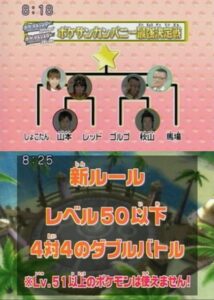
Bracket of the season-closing mini-tournament (top); new rules are coming (bottom). Stills from: Pokémon Sunday #206, via pocketmonsters.net
A week after the Japanese release of Platinum, Sunday aired its final Diamond & Pearl ruleset singles-battle segment (#206) in the form of a Pokésan cast mini-tournament to decide on the era’s strongest duellist. (In the finals, Baba handily defeated Shokotan to claim the title.) That same episode announced that a new ruleset was coming, and subsequent episodes put out ads seeking new challengers from the public. In November, the inaugural battle of the Platinum season took place when under the new rules, Yamamoto defeated Professor Red in a cast vs cast engagement (#213). Two episodes later (#215), Shokotan made her Platinum debut in an episode that also promoted the soon-to-follow Darkrai Member Card [LINK] distribution, apologetically posting a clean sweep of a primary schoolgirl’s team uniformly weak to Shoko Typhlosion’s fire type attacks. Then finally, a week later on December 7, 2008 (#216), it was Chief Golgo’s turn to launch his Platinum challenge contra visiting schoolboy Kenki.

Battle title card – note OTN “Goruchan” (top); Golgo leads with Magnezone and Sableye – note their nicknames (bottom). Stills from: Pokémon Sunday #216, via pocketmonsters.net
Following an exchange of pleasantries, the battle commenced – but not before the opening screen indicated that the Chief had opted to change up his Trainer avatar for Pokémon Platinum. While his D&P character had been female (named “Goruko”, or ごるこ), in Platinum he picked a more representative male protagonist named “Goruchan” (ゴルちゃん) after his own informal form of address on the show. When the arena loaded in, the Chief sent out a Sableye paired with – to nobody’s surprise – a Magnezone. It was nicknamed “Jibababan” (ジバババン), which was immediately understood to be a reference to his vocally creative movie role. (“バババ” is pronounced “ba-ba-ba”, ie. onomatopoeic for a lip-flapping sound!)
The battle started auspiciously enough for the Chief when his partner Jibababan took out an opposing Floatzel with Thunder as Sableye healed up after a severe hit from a mirror-matching Magnezone. From there, however, momentum shifted as Golgo could muster no effective counter to Kenki’s bulky Torterra. Jibababan succeeded in blasting an enemy Magnezone with Flash Cannon, but this proved to be Golgo’s last hurrah as his team got swiftly mopped up thereafter. As was tradition, to the victor went the spoils, and Kenki chose Sableye (nicknamed “Yamiramin”, or ヤミラミン) as his prize, graciously sending the Chief a powerful Garchomp in return. I’m frankly astonished Kenki didn’t go for Magnezone!
Some weeks after Golgo narrowly escaped the premature departure of his companion, Sunday announced that Golgo’s Mii would stop by Japanese “My Pokémon Ranch” on a downloadable visit with Jibababan in tow. Ranch, that Sinnoh storage WiiWare, saw a string of celebrity Mii visits throughout 2008-09 who mostly would provide cheery dialogue and mill about the farms’ Pokémon enclosures on a make-believe sightseeing tour. Some, however, would present signature Pokémon for trade.6 For a full list of Mii’s making an appearance in Ranch and associated trades, see here: https://w.atwiki.jp/pokefarm/sp/pages/51.html The Mii of Golgo’s colleague Akiyama, for example, had made port only three weeks prior and without much fanfare offered players his “John” (ジョン) Slaking in return for any ol’ Magikarp (January 6-19). Considering Jibababan’s burgeoning cult status, it seemed a certainty that Golgo would follow suit. But somehow, this was not the case. Golgo and Magnezone merrily lumbered and / or levitated about their hosts’ properties, and could be poked for commemorative photographs and snippets of information, but had not been programmed to bid farewell to one another – and enthusiasts like Pikachuftt were mightily disappointed for it.
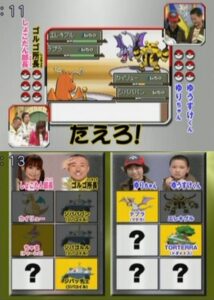
Jibababan bites the dust (top); the Magnezone meme team (bottom). Stills from: Pokémon Sunday #233, via pocketmonsters.net
Following this anticlimax in Ranch, players may have wondered whether Sunday was gearing up to walk the well-trodden “Emergency Distribution” path instead and celebrate homegrown hero Jibababan via a nationwide event release for Platinum – particularly so after Golgo’s Magnezone(s) stole the spotlight once again! Remember netapoke’s prediction that Golgo wouldn’t be Golgo if he didn’t try something silly with Magnezone? Well! Sunday episode #233 (aired April 5, 2009) featured a 6v6, four-player Platinum double battle, where the familiar pairing of Shokotan & Golgo took on a father-and-son team of challengers. As he had done earlier in the season, Golgo led with his trusty “Jibababan” Magnezone. However, it didn’t accomplish much before getting clobbered by, and falling to, an Earthquake from the foe’s Aerodactyl. (A move to which Magnezone is quadruple weak resulting from its Steel / Electric typing.) To everyone’s amazement, Golgo then sent out another Magnezone nicknamed “Jibagoruru” (ジバゴルル), which quickly found itself at the receiving end of another Earthquake, this one from a Torterra. Golgo’s closer was yet another Magnezone, this one nicknamed “Jibatche” (ジバッチェ), completing the meme team.
Up until this point, Shokotan’s more… Sensible performance had kept Team Sunday in contention. But then, at a critical moment in the battle, this final Magnezone fired off a Discharge – a move which hits all targets on the battlefield, including its sole remaining ally (Shokotan’s Scizor) which promptly went down. Well-played, Chief! Considering Golgo’s Magnezones were inspired by Zero’s original famous for its ineptitude and inability to accomplish much of anything, it was – if nothing else – a thematically appropriate conclusion to the battle. It’s also apparent that the Chief had not made a great deal of effort to bring the two fresh-faced Jiba’s up to speed: all reportedly ran Lock On, Discharge and Magnet Bomb, which is what Platinum’s Lv41 wild Magneton come with by default. (Discharge, at least, was cinematically congruent, as a move of Zero’s Magnezone.)
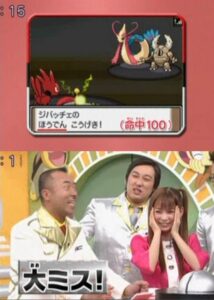
Discharge takes out Scizor (top); “Big Miss!” – 大ミス (bottom). Stills from: Pokémon Sunday #233, via pocketmonsters.net
In Sunday footage, an exasperated Shokotan can be seen unsure whether to berate Golgo for his throwing of the match, or submit to the great hilarity of his full Magnezone team with speaking nicknames. Well, sort of speaking. I was initially under the impression that their nicknames comprised a wordplay of sorts. But beyond a potential reference to the array of rumbling and rattling noises made by Golgo during his VA session (“ba-ba-ba”, “go-ru-ru”, “ba-chi-e”), the nicknames might have been purposely nonsensical. For that ties in perfectly with the type of character the Chief was on Sunday.
Even after this triple Magnezone takeover seized fans’ attention in characteristic fashion, a Sunday distribution announcement remained conspicuous in its absence. If only the Magnezones had won the day! Rather then being elected the object of veneration, a shroud of silence descended on Jibababan. With their comedic potential fulfilled, the Magnezones were not brought out again for the remainder of Platinum, and chances of immortalisation as a Sunday Special rapidly faded. On that sobering note: Was nobody, then, to get an opportunity to receive a signature Magnezone directly from the Chief?
Mischievous Gem Gremlin(s): Chief Golgo & Sableye
Whereas Golgo’s occupational branching out resulted in an overnight comedic connection between his persona and Magnezone, a concurrent Sunday plan to develop a more traditional battle-bond rapport between the Chief and another Pokémon – Sableye – proved to be a slow burn that experienced a few hiccups. The start of the Golgo-Sableye special relationship is hard to pinpoint. The Chief first fielded a generic Sableye in June 2008, during that last-ditch singles battle staged for Golgo to win back the prized “Octaan” Octillery in custody of his nemesis, Japanese schoolgirl Rika. While Sableye’s selection for such an important mission was evidence of great trust placed in the gem gremlin by the Chief, it nonetheless failed to live up to expectations, and did not secure the win in face of superior opposition.
This turned out to be somewhat of a recurring pattern for Sableye throughout the remainder of D&P era. It was chosen to defend Golgo’s honour a few more times, but never found itself able to make a true mark on battle’s course. As such, if there was any intent by Sunday to try and set up a reversal of fortune – a “Sableye Miracle”, if you will – and crown a new crowd favourite, this failed abjectly. When we consider the dubious combat merits of the average Sableye, its undistinguished track record is really not surprising. Despite an incredible Ghost/Dark typing that leaves it free of weaknesses, abysmal base stats ensure that Sableye keels over when a respectable foe breathes in its general direction. (Smogon rightly tiers it as bottom of the pack NU, for “never-used”.) It’s apparent, then, that Sableye did not serve the Chief all that well in D&P competitive battling, its fielding more often than not conferring a tactical advantage to Golgo’s opponent rather than to the Chief himself.
Still, as Pokémon transitioned into the Platinum era, Sableye’s underwhelming past performance did not discourage Sunday from a renewed attempt at casting the spotlight on it. Much like netapoke observers foresaw the coming of Golgo Magnezone, they in fact predicted the Chief might walk this route and recreate Sableye for a second battle stint.7 In the same Summer 2008 netapoke comment chain that speculated on a future Golgo Magnezone, one user hypothesised that the Chief might settle on a balanced 3v3 party of VA Magnezone, signature Octillery and occasional contributor Sableye. The product was “Yamiramin” (ヤミラミン): Platinum’s incarnation of its D&P predecessor, armed a with a new nickname for a metaphorical fresh paint job and, we can only hope, caught or bred to have an optimal nature and stellar IVs to give it at least a fighting chance. These stats were never disclosed, in part because – predictably – we didn’t get to witness its full might either (or whatever passed for it).
On Yamiramin’s first outing, which occurred alongside “Jibababan” Magnezone in episode #216 (as discussed above), its contribution was limited to use of a self-preserving Recover following a near-fatal hit, then sneaking in an ineffectual Confuse Ray before falling. While Yamiramin presumably carried either Shadow Claw or Shadow Ball for offensive presence, it did not get to use either. To add insult to injury after this usual lacklustre performance (which culminated in defeat), Golgo’s show-visiting opponent picked the Chief’s newly-recruited Platinum Sableye as his prize. This meant that Yamiramin was promptly and permanently traded away, scuppering any plans Sunday might have had to develop the Pokémon into a battle fixture synonymous with Golgo. (In case you’re wondering what kind of name “Yamiramin” is anyway, it’s basically the Japanese name for Sableye (ヤミラミ) with an extra -n (ン) appended for style. Not much of nickname, really.)
The deception that was the permanent loss of Yamiramin looked to spell a premature end to the fledgling bond between Golgo and Sableye. The Chief did not catch and/or raise another for the remainder of Sunday’s Platinum season. Deprived of the opportunity to prove itself in battle, there was no chance for Sableye to be enshrined in Ranch or as a direct Sunday Special. In fact, Golgo Sableye seemed imminently headed for the scrapheap of Pokémon Sunday history, destined to be forgotten. But the inverse held true!
We can only assume that the prospect of a special relationship between Chief Golgo and the Pokémon Sableye was something that Sunday’s writers long considered a healthy addition to the show. For when the organic route to a starring role for the purple gremlin failed to produce the desired result, Sunday simply brute-forced it by introducing Sableye as a recurring costumed character on its cast with a deep affinity for Golgo anchored in the show’s very lore! This mascot Sableye debuted on Sunday #235 (aired April 19, 2009), where it was unveiled after being draped in a black cloth that did a rather poor job of concealing its identity. In this episode, Golgo explained how he “caught” this new costumed Sableye in Harajuku (a Tokyo district) and instantly took to him. Sableye, in turn, wasted no time illustrating its mischievous nature, drawing the Chief’s attention to a conspicuously placed purple gift box that, as soon as the Chief leant over it to examine it, revealed itself to be smoke trap that promptly went off in Golgo’s face. “It’s the work of Sableye!”, cried Sunday’s cast in unison, before the gem gremlin rushed over to Golgo for a reconciliatory hug.
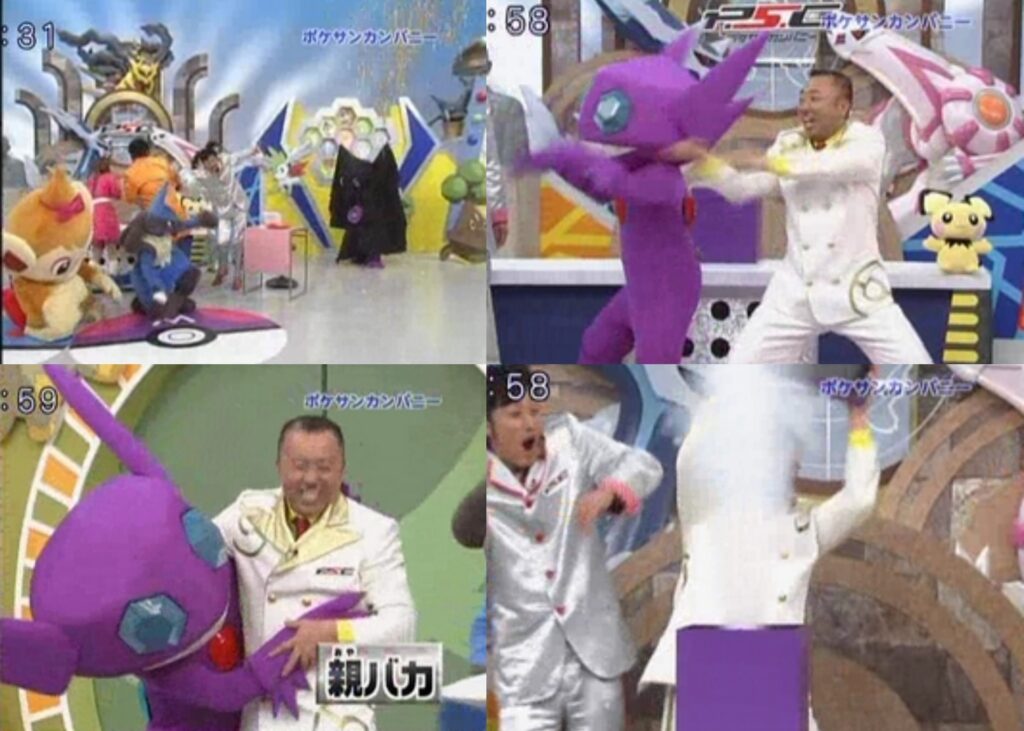
Clockwise, from top-left: (1) Sableye under the drape – note its woopie cushion; (2) Golgo and Sableye dance a jig; (3) It’s a Smoke Trap!; (4) Making amends. Stills from: Pokémon Sunday #235, via pocketmonsters.net
From this moment onwards, Sableye was to appear frequently on Pokémon Sunday in dedicated segments where he ventured out to locations in the Greater Tokyo area on mischievous solo fact-finding missions. In addition, this costumed Sableye accompanied Golgo and Professor Red whenever and wherever they had Pokesan business, there too acting as a mischief-maker inseparable from the Chief. Finally, it rapidly became known for pulling all manner of tricks, pranks and shenanigans on the show, its favourite being zealous overuse of the woopie cushion (to the point where PC Tokyo stocked a Sableye-themed one as purchasable merchandise). There is much more to observe on this subject, but that discussion is best saved for another day when it is more topical (e.g. when analysing 2013’s Smash Sableye). Suffice to say that Sunday’s writers got what they desired: a canonical unique bond between Golgo and Sableye, even if it famously took Sunday’s TV audience some time to warm up to the naughty gremlin!
Whew, okay. Now that you’ve been introduced to both Magnezone and Sableye, let’s shift tack a little… To the moment where select individuals in the world outside of Japan had the privilege of becoming acquainted with Golgo’s love for both.
Entrez: The 2009 World Championship “Goruchans”
The Pokémon World Video Game Championships (VGC) have been the undisputed pinnacle of online competitive Pokémon for so long that it’s hard to remember a time before it. But like everything Pokémon WiFi, the modern guise of “Worlds” took shape only with Generation Sinnoh. As mentioned in the introduction to this article, Pokémon Sunday was there to provide exclusive TV coverage of the 2008 inaugural “Showdown” edition (episode #203) held alongside the TCG World Championships. Special reporter Akane Kabeya (of the short-lived Daisuki Now) travelled to Orlando, Florida on Sunday’s behalf to take stock of the goings-on, chatting with the Japanese delegation, trading TCG cards with kids from around the world, and even interviewing GameFreak Director Junichi Masuda who, too, had flown in for the occasion. From Akane’s reporting emerges the impression of a wireless gaming competition somewhat uncomfortable in its own skin and shuddering at the prospect of the all-consuming juggernaut competitive battling might soon become. The 2008 Showdown, then, had the trappings of a road test; a general rehearsal, perhaps, organised chiefly to iron out the technical and logistical kinks ahead of the future first true VGC World Championships. For when the Pokémon World Championship circus descended on San Diego, California in August 2009, it incorporated under its banner the global finals of a fully-fledged Pokémon Platinum-based battling competition now of official World Championship status.
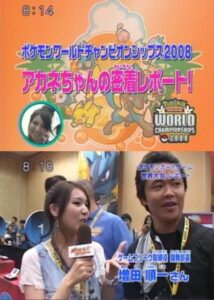
Akane reporting for duty (top); with Junichi Masuda at Worlds 2008 (bottom). Stills from: Pokémon Sunday #203, via pocketmonsters.net
Pokémon Sunday’s presence at the event had been upgraded, too, with the show’s very own Professor Red and Chief Golgo taking over from Akane as reporter-representatives. Of great interest to us, Sunday episode #254 (aired August 30, 2009) broadcast a short special feature chronicling their business trip overseas and experiences at the Worlds ’09 event venue. And before you ask: Yes, Golgo Matsumoto and Red Yoshida very much attended in the capacity of their Sunday personae, dressed in the usual eye-catching Pokémon-inspired uniforms (disarmingly clownesque for Red, flamboyantly authoritative for Golgo). Having made a glamorous entrance by rickshaw – I guess a sedan chair wasn’t available – Golgo and Red proceeded to playfully report on the ins-and-outs of the tournament much like Akane had done the year prior. The episode very purposely explained the concept of VGC to its television audience, introduced Japan’s delegation at the event, aired footage of the opening ceremony, explained the various competition age categories, and perhaps most important of all: it showed Golgo and Red interacting with fans and participants.
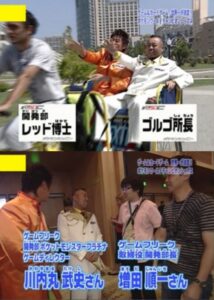
Red and Golgo arriving… In style? (top); A Sunday-GameFreak get-together on US soil (bottom). Stills from: Pokémon Sunday #254, via pocketmonsters.net
As an aside – much like Akane had, the pair also encountered Junichi Masuda roaming the halls,8 As I type this, I can’t help but picture in my mind’s eye the contentedly strolling Rollercoaster Tycoon avatar of Chris Sawyer, pausing occasionally only to take a photograph of this thing or another reflecting his own incredible accomplishment. this time accompanied by Pokémon Platinum Game Director Takeshi Kawachimaru (川內丸 武史). By his own description, over 130 people lined up to get his autograph during a signing session. (In case you hadn’t pieced it together yet, this article’s opening quote is from Masuda’s blog!) One contemporary journalistic source alleges that Pokémon founding-father Satoshi Tajiri and Pokémon Company President Tsunekazu Ishihara graced Worlds 2009 with a visit, too. The advent of combined World Championships must’ve felt like a momentous occasion to GameFreak – another incredible milestone for a company that has gone from strength to strength the past 25 years.
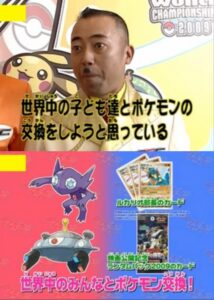
“I’m thinking of exchanging Pokemon with children from all over the world” (top); Sableye and Magnezone up for grabs! (bottom). Stills from: Pokémon Sunday #254, via pocketmonsters.net
Now, Sunday’s “Worlds” special feature closed out with a short segment detailing Red’s and Golgo’s efforts to trade with international participants. Emulating the example set by Akane, Red chose to exchange TCG cards with several kids, giving out Japanese Sunday-stamped “Director Lucario” promos in return for various retro reverses and holofoils. Golgo, meanwhile, opted to organise a small-scale digital giveaway of Pokémon from his Platinum version, presumably to celebrate the coming of age of virtual battling. This being the official VGC – with a Worlds ’09 Weavile [LINK] up for grabs to boot – many competitors and casual visitors could reasonably be expected to carry Nintendo DS’s, thus affording Chief Golgo the perfect opportunity to extend his undying love for Magnezone and Sableye with the world. Knowledge of these obscure quasi-event Pokémon has survived in the Western Pokémon community, where they are known colloquially as the “Goruchans”, after Golgo’s Platinum OT. (Yes. We’ve finally arrived at the heart of the matter!)
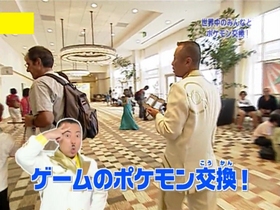
The Chief wandering the venue in search of trades. Still from: Pokémon Sunday #254, via pocketmonsters.net
As you may have sensed, we know precious little about the Goruchans. The bulk of our information comes from contemporary footage aired on Sunday, supplemented by the firsthand account of a passionate observer. Let’s start with the show. In stills courtesy of Pocketmonsters.net, we can see Golgo signal his intent to exchange Pokémon with foreign children in attendance at the event. Directly afterwards, the episode cut to a title card making it explicit that the Pokémon he would be offering up were to be personal favourites Magnezone(s) and Sableye(s). Subsequent shots saw him wander the venue in search of suitable candidates, and when the dust had settled, he had made four total (documented) trades, each with a kid from a different country participating in junior division categories (<13). Said trades were:
– Sableye for Porygon2 (with Russell, from Germany);9German Pokésite bisafans.de blogged about Worlds09, and included in the article several photographs supplied by German delegate Russell, better known by the nickname “flummi”. See here: https://www.bisafans.de/weiteres/tourberichte/tourbericht-0015.php
– Sableye for Zigzagoon (with Batista, from France);
– Magnezone for Dragonair (with Arthur, from Mexico);
– Magnezone for Drifloon (with Stefano, from Italy).
Sunday took deliberate care to show off the foreign language Pokédex entries resulting from Golgo’s trades. But agonisingly for us, Sunday stopped short of telling its viewers anything at all about the outbound Magnezone and Sableye. Now, it’s perfectly apparent that this was a small-scale operation: just several straight one-on-one virtual Pokémon Platinum trades between Golgo and an (un)lucky chosen few, and nothing more. While we can infer that Magnezone and Sableye’s Original Trainer Name must’ve been “Goruchan” (ゴルちゃん), the OT of the Chief’s Platinum, Sunday did not think (or consider it worthwhile) to disclose any of their essential details, that is their current levels, their movesets, their TID, or even whether they were nicknamed like Golgo’s “Battle Corner” Magnezone and Sableye had been. In fact, the show didn’t furnish us with a scrap of detail that would help us identify an authentic Goruchan, if we somehow got to lay eyes on one. Altogether the trading segment barely took up two full minutes – a breezy distraction in the grand scheme of Sunday’s Worlds reporting, and our information paucity reflects that.
Thankfully, by a stroke of great fortune, we have been handed another pathway to (partial) documentation and, miraculously, preservation! Quite a few American Pokémon aficionados present at the event actually recognised the pair of Golgo and Red, and multiple posed for photo-ops with them – a fact that Sunday’s event coverage sought to highlight.10 Even though Pokémon Sunday never aired outside of Japan, Golgo and Red were recognised by quite a few international fans, some of whom posed for photo-ops with the pair. Broadly speaking, anno 2009 Pokémon Sunday was approaching the zenith of its fame both at home and abroad, courtesy of such iconic on-air reveals as the Zoroark silhouette (#277) and the Pokewalker (#242) as well as elaborate HeartGold & SoulSilver preview material – information that naturally found its way to Western fansites and media outlets. Among them was a member of Pokémon Secure, an erstwhile event collecting group. Not only did this “Aleksandar426” spot Golgo and pigeonhole him as the co-star of Pokémon Sunday, he also caught wind of the fact that the Chief was trading out his certain of his personal Pokémon to attendees. As soon as Aleks learned of this, he made an concerted effort towards obtaining them – amassing information on their species in the process. Recalling the happenings of that fateful weekend some seven years later on Project Pokémon forums, Aleks volunteered the following anecdote:
“When I went to WO[RL]DS09 I saw Gorugo of Pokémon Sunday (guy wi[t]h the … mustache) going around and trading people from different countries. […] I’m not sure how many he gave out but I know on that day he gave out at least 5 because he was only looking for people from specific countries. […] [H]e didn’t seem like he wanted to trade anyone who was over 13.”
Wow. I wonder if Aleks made an inadvertent cameo in Sunday’s mini-documentary! Either way, in the best possible triangulation scenario, Aleksandar’s eyewitness account rhymes perfectly with the Golgo trading footage broadcast by Sunday: Golgo traded exclusively with individuals from countries with specific, Pokédex-registrable European languages (German, French, Spanish, Italian), and these individuals had to be – in keeping with Sunday’s primary audience – young children.11Mexican Arthur appears to have played Platinum in English – a situation not too uncommon, I’m told, due to better availability of the English language software (over Spanish) in the country.
Intriguingly, Aleks went on to comment on Project Pokémon forums that he successfully negotiated the acquisition of two Pokémon from children who had received them directly from the Chief:
“I managed to get 2 of the Pokémon he traded while I was in line for autographs … [A] Piplup [that] was from a kid who traveled from France and the Magnezone was given to a kid from Spain. […] Only 2/5 of the kids were willing to trade the Goruchans and even then it took a lot of convincing and a lot of time finding translators to convince the kids.”
Poor kids. Now, this mention of Piplup is puzzling. Golgo was not supposed to give out any Piplup! If he in fact did, it can only have been an unplanned exchange that occurred in the sidelines of Magnezone and Sableye, perhaps made under pressure to appease children who felt left out. Our source Aleksandar wrote that Piplup came to him via a French kid; however, Sableye-receiving Batista already represented the Tricolore, and while theoretically possible that Batista received both Sableye and Piplup from Golgo, this is somewhat unlikely. Whatever its precise origin, the Piplup procured by Aleksandar was subsequently extracted in .pkm file format and uploaded to Pokémon Secure file forums where it was accessible (in cloned form) only to ranking insiders, its spread closely monitored. As such, Piplup never came into mass circulation, and the privileged few who jealously guarded it are today on extended hiatus and/or retired outright from trading, so for the time being we must consider the enigmatic Piplup lost.
The origins of Magnezone, too, are subject to some debate. We can infer that it came to us through Arthur (whom Aleksandar misidentifies as Spanish – same mother tongue!). But, who traded Arthur? Although Aleks initially conveyed matter-of-factly that he’d personally co-acquired Piplup and Magnezone, competing evidence suggests that Magnezone came to us by way of veteran trader “ddog” who, like Aleks, had been in attendance at World’s09. Writing on Secure‘s forums in the event’s immediate aftermath on August 15, 2009, ddog summarised his World’s trading experience in precisely one line of text, sharing how “I traded with the host of Pokémon Sunday [and] he gave me a Magneton [sic], nothing really special about it other than it’s from his personal game.”12See: https://www.tapatalk.com/groups/pokemon_secure/viewtopic.php?p=131805#p131805 Was ddog, then, the original source of the Golgo Magnezone that has been bequeathed to us?
It goes without saying that ddog’s one-liner statement is problematic. For starters, such little imprint did Golgo’s creatures make on the unimpressionable ddog that the latter misremembered the Pokémon species – a Magnezone, friend, not a Magneton. (Unless, of course, an unplanned evolution took place somewhere down the line, which in would raise a host of other questions. So, applying Occam’s Razor – ddog made a typo.) Second, ddog omitted how, in all likelihood, his trade for Magnezone had passed through the aforementioned Arthur, and hadn’t transpired as a mano-a-mano with Chief Golgo himself. Aleks, after all, had stated pointedly that Golgo sought out junior league international participants for his exchanges, a criterion that ddog did not meet. Still, despite these caveats, we must consider the plausibility of ddog as Magnezone’s source, not in the least because recent (2023) correspondence with Aleks corroborates this interpretation. Wrote Aleks: “After a few days [past Worlds09] I asked around if anyone else had a Pokémon with the similar backstory and found only 1 other player who happened to have a Magnezone”.13 Author’s correspondence with aleksandar426, July 1 2023 This player can only have been ddog.
Whatever the case, from ddog’s Magnezone we can draw some tentative conclusions about Golgo’s Platinum save file and in-game actions, as well as speculate on the characteristics of the second Magnezone plus the two Sableye gifted to Stefano, Batista and Russel, respectively.
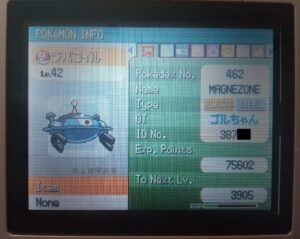 For starters, Arthur’s Magnezone yields the curiosity of Chief Golgo’s Platinum Trainer ID (387XX) and SID. (Sorry guys, I have to redact these digits – I’m sure you understand.) I’ve sought to match this against primary evidence from Sunday, but at no point during its televised “Battle Corner” segment did the show reveal Golgo’s Platinum information.14Unlike Golgo’s Diamond / Pearl TID, which is publicly known. Also, for those of you who (quite logically) expected Magnezone to have a non-sequitur Golgoesque nickname, I sadly must disappoint: Arthur was given a plain, uncustomised Jibacoil. I initially wondered whether the Magnezone might’ve been a reject from the pair Golgo raised for the show, but a catch date of August 9 – mere days before Worlds, which kicked off August 13 – suggests otherwise. That it came in a Repeat Ball makes perfect sense, as the Goruchans were likely the fourth and fifth Magneton (or, possibly, Magnemites) he caught.
For starters, Arthur’s Magnezone yields the curiosity of Chief Golgo’s Platinum Trainer ID (387XX) and SID. (Sorry guys, I have to redact these digits – I’m sure you understand.) I’ve sought to match this against primary evidence from Sunday, but at no point during its televised “Battle Corner” segment did the show reveal Golgo’s Platinum information.14Unlike Golgo’s Diamond / Pearl TID, which is publicly known. Also, for those of you who (quite logically) expected Magnezone to have a non-sequitur Golgoesque nickname, I sadly must disappoint: Arthur was given a plain, uncustomised Jibacoil. I initially wondered whether the Magnezone might’ve been a reject from the pair Golgo raised for the show, but a catch date of August 9 – mere days before Worlds, which kicked off August 13 – suggests otherwise. That it came in a Repeat Ball makes perfect sense, as the Goruchans were likely the fourth and fifth Magneton (or, possibly, Magnemites) he caught.
It’s interesting how the composition of Arthur’s Goruchan points to considerable commonality with Sunday’s latter-day Jibas. Movesets are an important clue: the “Goruchan”, Jibagoruru and Jibatche all ran Lock On, Discharge and Magnet Bomb (and not Thunder Wave, Supersonic, or other early learnset moves, let alone fancy TMs).15Arthur’s Goruchan additionally has Screech, while we might assume that the Jibas had at least Mirror Shot in that slot (which Magnezones learn at LV.46). This rather particular combination of attacks is quite illuminating, as it strongly suggests a common site of origin for all three (or four) Magnezones. Arthur’s Goruchan was caught on Route 222, which in Platinum is home to wild Magneton carrying – you guessed it – Lock On, Discharge, Magnet Bomb and Screech. When in urgent need of self-reared Magnezones, the quickest path certainly is to snag the immediate precursors and rush their evolution.
Which appears to be exactly what Golgo did. The fact that Goruchan Magnezone remained practically unaltered from its wild brethren suggests that it was rushed straight to Mt. Coronet for a single level-up (from Lv.41 to 42) and prompt on-site evolution, after which Golgo called it a day.16In Generation Sinnoh, Magneton evolve exclusively inside of Mt. Coronet on level-up. While we have no data whatsoever for the second Goruchan Magnezone received by Italian Stefano, I think it’s a safe assumption that it mirrored Arthur’s. The latterly Jibas, too, may have walked this same path, with a dollop of additional training to beef them up for combat. The outlier in this whole shebang is quite obviously Golgo’s oldest and most famous Magnezone, Jibababan, which, if I had to guess, accompanied the Chief on his Platinum adventure from an early stage. (Its Supersonic move is a strong indicator in this regard.)
Now, armed with this knowledge, we can cautiously extrapolate what the “Goruchan” Sableyes may have looked like. The pair of gem gremlins was likely caught on Iron Island – Sableye’s sole habitat in Platinum – possibly in Repeat Balls, like the Magnezones. Golgo would have nicknamed neither, and if the Magnezones are any guide, he gave them out untrained and unaltered; that is, at a base encounter level of 30-34 with on-catch movesets of Detect / Shadow Sneak / Knock Off / Faint Attack. It is unknown whether Secure’s contact Aleksandar had eyes on Russel’s and Stefano’s Sableyes at all, but if he did, he did not offer – or was unable to obtain – specifics. Nor do we have much hope to fill in the blanks. This many years on, the full details of these Goruchans are simply unknowable. …Unless Russel from Germany and Batista from France are still out there, somewhere. Fellas, if you happen to read this, somehow, some day, please do get in touch! We’d love to document your Sableye for posterity!
- Harvest Moon 3 (2001) - March 5, 2020
- Pokémon Trading Card Game 2 (2001) - February 5, 2020
- Yu-Gi-Oh! Dark Duel Stories (2002) - January 5, 2020

